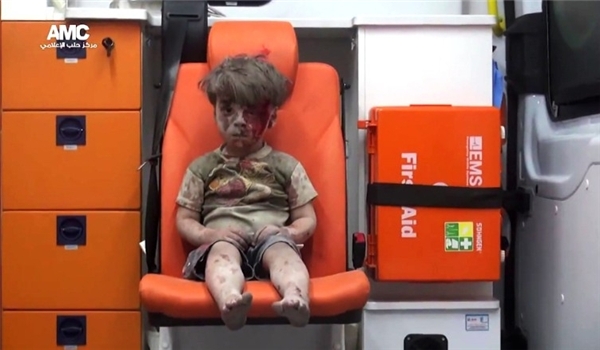
RNA - The father of Omran that was to the center of media's attentions last year and was supposed to be killed in airstrikes disclosed that he did not accept tempting offers of media sources affiliated to terrorist groups to accuse the Syrian Army (of blind attacks on civilians in Aleppo).
The father of Omran that is still living in Aleppo told al-Mayadeen channel that he did not hear any sound made by fighter jets or air-to-surface missiles targeting his house.
"We did not find out how the incident happened. I pulled my family members out of debris. Omran was with me, while White Helmets took him away and started taking photo of him," the father of Omran added.
He added that some of the journalists close to Al-Nusra Front (also known as Fatah al-Sham Front or the Levant Liberation Board) demanded him to say that the attack on his house was done by Damascus government but he did not accept their offer.
The father of Omran went on to say that the journalists offered a hefty of money to him to tell about the incident as they want in front of media.
This image of Omran is the first one that has been seen publicly since his bloodied and dusty photo in the back of an ambulance in Aleppo went viral after he was rescued from a destroyed building in the Qaterji neighborhood in Aleppo city.
Omran Daqneesh is a five-year old Syrian boy who gained media attention after footage of him injured in an alleged airstrike by Syrian pro-government forces appeared on the Internet.
Omran was wounded on August 17, 2016, in an alleged Russian Air Force's air raid on the militant-held Qaterji neighborhood. He was taken to a hospital known as M10 and later was released.
Omran's family never fled the city after the incident and remained loyal to Damascus government and Syrian President Bashar al-Assad.
The image of the kid sitting bloodied in an ambulance after being dragged from the rubble of his home caused international outrage and was widely featured in newspapers and social media. It has been compared with photographs of Alan Kurdi, a child refugee of the war who drowned trying to reach Europe.
Omran's photo, along with several others from the attack, was published online by the Aleppo Media Center, an anti-government activist group looking to draw attention to the plight of civilians inside the city.
Iranian, Russian and Chinese media, allies of Damascus, called the images "propaganda", while some international media proposed that the image was staged.
In mid-May, former White Helmets associate Walid Hindi admitted his involvement in fabricating photo and video material, prepared in cooperation with the Turkish Television, during the time when he was working with the notorious group in Eastern Aleppo.
The group prepared fake videos of alleged atrocities of the Syrian army, during the liberation process of Eastern Aleppo.
In his confession, broadcasted on Syrian National Television at the time, Hindi admitted to have worked with White Helmets for three years and received rather huge sums of money, a major portion of which was provided by the Persian Gulf states.
He also described how filming of “atrocities” would take place.
When, for instance, they wanted to stage an airstrike scene, the filming crew would fire sirens and the actors would then immediately rush to the scene. Right after that, live streaming of events would begin, accusing the Syrian Army of carrying out yet another airstrike, targeting civilians. Hindi said he participated in fabricating videos more than just once.
According to Hindi, the main person responsible for “directing” these staged videos was Ibrahim Al Hajj, with Mohammad Al Sayed being the main cameraman.
Also, another former associate named Imad Abdul Jawad admitted to have witnessed possession of chemicals by terrorists in Aleppo, saying “During my work shift as a guard I was once asked to transfer a bunch of barrels, containing something that my supervisors called “detergent and washing powder”.
"I was supposed to transfer the materials from the district of Al Sukkariyeh to the district of Amariya,” he added.
He then explained that his task was basically to unload the wares at the entrance of the building, pointing out that on one occasion, after finishing unloading the content, he saw people wearing uniforms, silver masks and protective boots and were carrying the goods he just transported to the cellars.
On one occasion, Jawad managed to get closer and he saw people opening the barrels and pouring their content out into something that looked like gas cylinders, adding that contents looked nothing like washing powder or detergent. He described the liquid, which was being poured out of the barrels, to have a rather foul smell. When his boss noticed he is watching the procedure, he was dismissed immediately.
847/940